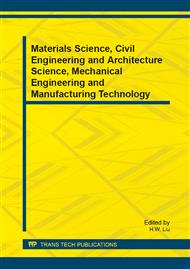p.1039
p.1043
p.1047
p.1052
p.1057
p.1061
p.1064
p.1070
p.1074
Fatigue Research on Excavator Boom Driven by Real Loads
Abstract:
The difficulty to simulate the complex loads in the fatigue analysis of excavator working device results in great error in the result, so a research method of fatigue life of working device that was completely driven by real loads was proposed. With a 20t excavator as the research object, a kinetic model of excavator working device was established using the D-H method. According to the hydraulic cylinders pressure and displacement data in the process of digging recorded by the sensors, the real working loads of booms hinge points were obtained combining the equation of forces. The life contour of boom was obtained by the fatigue analysis of boom using software MSC.Fatigue. The minimum fatigue life is 16.8 years, and the result of the study provides basis for designing excavator working device structure.
Info:
Periodical:
Pages:
1057-1060
Citation:
Online since:
January 2014
Authors:
Keywords:
Price:
Сopyright:
© 2014 Trans Tech Publications Ltd. All Rights Reserved
Share:
Citation:


